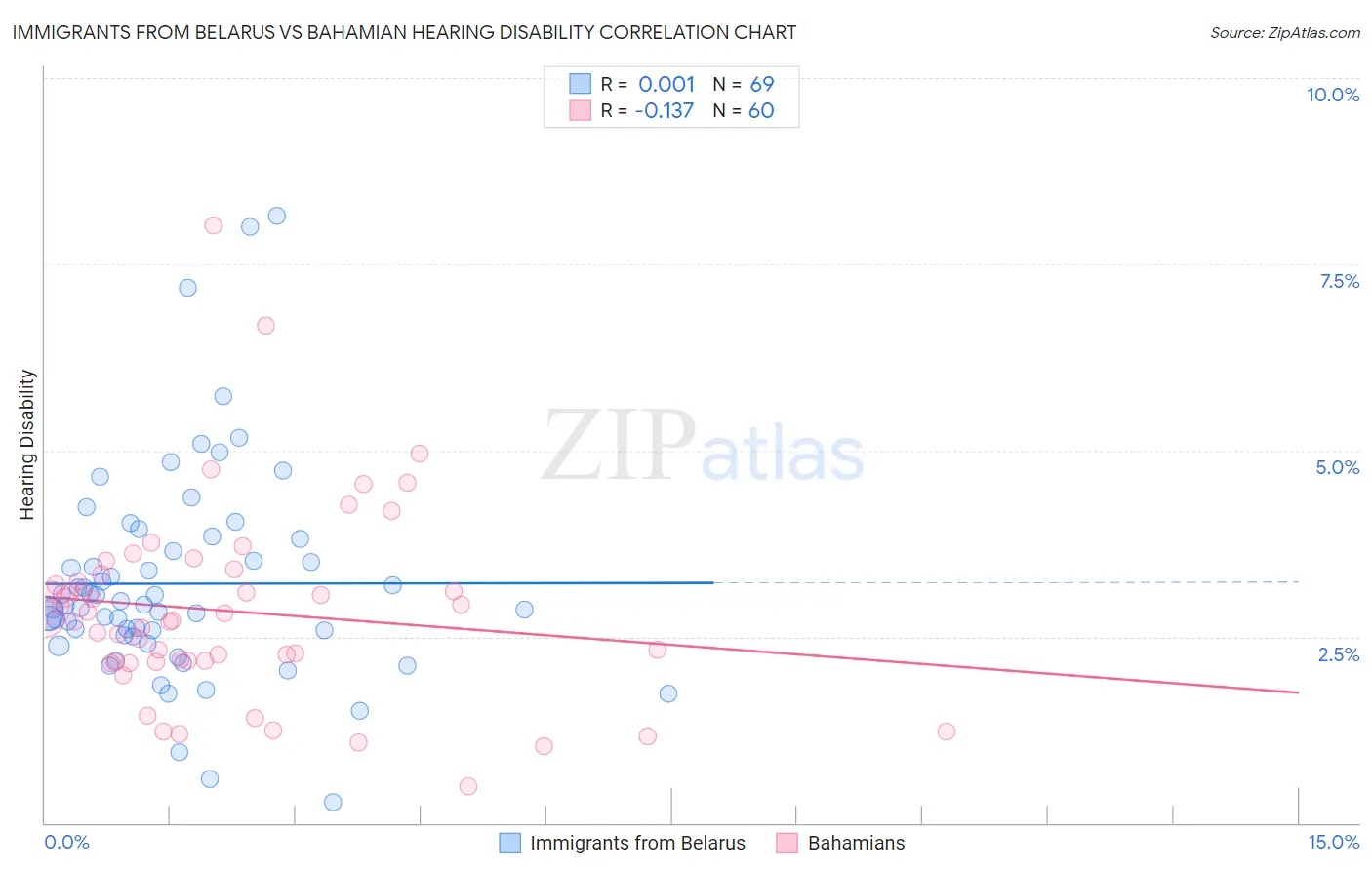Immigrants from Belarus vs Bahamian Hearing Disability
COMPARE
Immigrants from Belarus
Bahamian
Hearing Disability
Hearing Disability Comparison
Immigrants from Belarus
Bahamians
2.8%
HEARING DISABILITY
91.6/ 100
METRIC RATING
113th/ 347
METRIC RANK
2.9%
HEARING DISABILITY
88.6/ 100
METRIC RATING
124th/ 347
METRIC RANK
Immigrants from Belarus vs Bahamian Hearing Disability Correlation Chart
The statistical analysis conducted on geographies consisting of 150,178,365 people shows no correlation between the proportion of Immigrants from Belarus and percentage of population with hearing disability in the United States with a correlation coefficient (R) of 0.001 and weighted average of 2.8%. Similarly, the statistical analysis conducted on geographies consisting of 112,647,902 people shows a poor negative correlation between the proportion of Bahamians and percentage of population with hearing disability in the United States with a correlation coefficient (R) of -0.137 and weighted average of 2.9%, a difference of 0.85%.

Hearing Disability Correlation Summary
| Measurement | Immigrants from Belarus | Bahamian |
| Minimum | 0.28% | 0.49% |
| Maximum | 8.1% | 8.0% |
| Range | 7.9% | 7.5% |
| Mean | 3.2% | 2.8% |
| Median | 2.9% | 2.7% |
| Interquartile 25% (IQ1) | 2.5% | 2.2% |
| Interquartile 75% (IQ3) | 3.7% | 3.3% |
| Interquartile Range (IQR) | 1.2% | 1.1% |
| Standard Deviation (Sample) | 1.4% | 1.3% |
| Standard Deviation (Population) | 1.4% | 1.3% |
Demographics Similar to Immigrants from Belarus and Bahamians by Hearing Disability
In terms of hearing disability, the demographic groups most similar to Immigrants from Belarus are Cambodian (2.8%, a difference of 0.17%), U.S. Virgin Islander (2.8%, a difference of 0.31%), Immigrants from Latin America (2.8%, a difference of 0.34%), Immigrants from Yemen (2.8%, a difference of 0.39%), and Immigrants (2.8%, a difference of 0.41%). Similarly, the demographic groups most similar to Bahamians are Immigrants from Zaire (2.9%, a difference of 0.010%), Immigrants from Albania (2.9%, a difference of 0.030%), Liberian (2.8%, a difference of 0.10%), Cuban (2.8%, a difference of 0.19%), and Immigrants from Sudan (2.9%, a difference of 0.19%).
| Demographics | Rating | Rank | Hearing Disability |
| Guatemalans | 93.2 /100 | #108 | Exceptional 2.8% |
| Turks | 93.0 /100 | #109 | Exceptional 2.8% |
| Cypriots | 92.9 /100 | #110 | Exceptional 2.8% |
| Immigrants | Yemen | 92.7 /100 | #111 | Exceptional 2.8% |
| U.S. Virgin Islanders | 92.5 /100 | #112 | Exceptional 2.8% |
| Immigrants | Belarus | 91.6 /100 | #113 | Exceptional 2.8% |
| Cambodians | 91.1 /100 | #114 | Exceptional 2.8% |
| Immigrants | Latin America | 90.5 /100 | #115 | Exceptional 2.8% |
| Immigrants | Immigrants | 90.3 /100 | #116 | Exceptional 2.8% |
| Immigrants | Liberia | 90.0 /100 | #117 | Excellent 2.8% |
| Zimbabweans | 89.9 /100 | #118 | Excellent 2.8% |
| Kenyans | 89.8 /100 | #119 | Excellent 2.8% |
| Jordanians | 89.5 /100 | #120 | Excellent 2.8% |
| Cubans | 89.4 /100 | #121 | Excellent 2.8% |
| Liberians | 89.0 /100 | #122 | Excellent 2.8% |
| Immigrants | Zaire | 88.6 /100 | #123 | Excellent 2.9% |
| Bahamians | 88.6 /100 | #124 | Excellent 2.9% |
| Immigrants | Albania | 88.5 /100 | #125 | Excellent 2.9% |
| Immigrants | Sudan | 87.8 /100 | #126 | Excellent 2.9% |
| South American Indians | 86.9 /100 | #127 | Excellent 2.9% |
| Immigrants | Western Asia | 86.9 /100 | #128 | Excellent 2.9% |